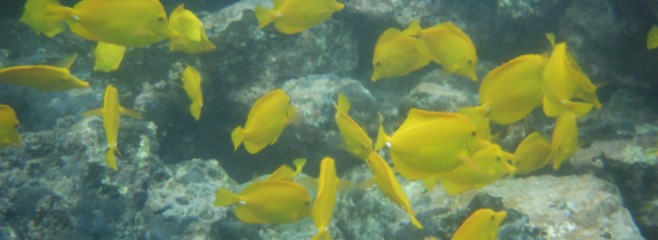Monday- We started the week off with a series of lectures introducing us to the world of humpback whales and bioacoustics. Teaching us this week was Adam Frankel, vice president of the Hawaii Marine Mammal Consortium. The `ohana was given a brief overview of bioacoustics, which is the study of sound production, dispersal, and reception in animals. Adam spoke about his research on the effects anthropogenic sound has on marine mammals, specifically humpback whales.
We learned about the ways scientists monitor bioacoustics and face the challenges of working in the ocean. One way scientists do this is by monitoring sound in the ocean with a vehicle called the Wave Glider (picture below). This instrument uses the energy of the ocean waves and solar radiation to power itself, making it completely autonomous. The Wave Glider acts as a platform for bioacoustics tools and can travel the ocean for months at a time collecting data.
With newly found knowledge of the Wave Glider, we took an afternoon field trip to Liquid Robotics to see one in person. Liquid Robotics builds customized Wave Gliders for a variety of clients – from researchers wanting to monitor whale songs to the coast guard looking to keep our borders safe. At Liquid Robotics we were given a tour of the facility and learned about some of the projects the company is working on now. To many of us, the best part of the tour came when we found out we most likely would see a Wave Glider in the water our on adventures during the week. Our tour guide gave us special permission to touch them and check them out if we found one as long as we stayed away from the cables – we were on a mission to find ourselves a wave glider!
Tuesday- Our mission for this day was to find some singing humpback whales. The group traveled to Puako where we took a boat out to look for singers. Adam used a recording device to record singers while we watched for breaches, tail slaps, and any other signs of the whales. The day was perfect, we saw beautiful whales and even had one swim under our boat – luckily he didn’t come up and tip us over! Throughout the day we kept our eyes open for wave gliders and we found one. Once spotted, the `ohana got their snorkel gear on and jumped into the water to check out the instrument. As we dived down into the water we could hear the whales singing. Needless to say we had a whale of a good time!
Wednesday- Wednesday we had a “snow day”! The rain came and stayed for the day washing out our plans to go whale watching, so we had lectures and prepared for Thursday.
Thursday- With the rain gone, we headed toward Kawaihae to a shore look out point. Once there we met up with Adam and two other members of his team. At the shore point we were broken up into groups to help with their project. Three of us helped collect data, three others used binoculars to watch the ocean closely for whales and boats, and the rest of us scanned the horizon looking for any signs of movement.
For the first hour we worked to spot as many whales as possible, indicating whether or not we saw a mom, calf, or male escort. Our goal was to identify as many pods as we could while tracking their movement and surface activity. The last hour required us to silently observe the area we were studying, while one person counted the number of whales they saw. Because data collection does not occur in large groups of 20 very often, using one person to count the number of whales they saw in one hour helps control the data, making it comparable to other data collection events. At the end of data collection we celebrated with homemade chocolate chips cookies!
When we returned home we found some new house guests – baby chicks! These chicks will be our pets until we leave in May. When we leave, the chicks will go to a farm run by one of the program’s alumni. In January when `ohana 2016 arrives, the chicks will return all grown up. Think of it as cooperative chicken housing!
Friday- After a week of whale watching we headed to the Mauna Loa observatory to learn about climate change. The Mauna Loa observatory has been monitoring atmospheric changes since the 1950’s and is perfectly suited for this because of its location. The Mauna Loa Observatory sits approximately 11,000 feet above sea level in undisturbed air with no nearby vegetation and human disturbance.
We got a tour of the observatory, learning about the type of work they do, such as monitoring CO2 levels, ozone depletion, and air quality. Just when we thought we’ve seen it all, we got to see the telescope they use to monitor solar activity. My favorite piece of information I learned was that there is an 8-minute delay between what we observe with sun and what is happening due to the distance away in the solar system. So if the sun disappeared, we wouldn’t know about it for 8 minutes! But not to worry, they assured us that wouldn’t be happening anytime soon.
Mahalo for reading!
-Krysden








